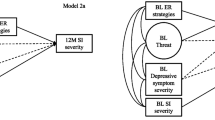Abstract
A sample of 137 college women's retrospective reports of childhood sexual abuse were examined in order to identify the emotional responses these victims experienced at the time of abuse and to investigate the relationship between these responses and the long-term effects of abuse. Results identified three important dimensions of responding including guilt/fear, anger/disgust, and positive emotions. Further, five groups of victims displaying unique emotion profiles were identified. These include: (a) guilty/fearful individuals, (b) low responders, (c) angry/disgusted individuals, (d) ambivalent individuals, and (e) positive individuals. It was determined that victims' responses to abuse were associated with abuse severity. Finally, victim's affective responses to abuse were related to subsequent adjustment. Individuals experiencing high levels of guilt/fear were identified as exhibiting poorer social adjustment than either individuals reporting primarily anger or disgust or individuals reporting low levels of all emotions. Possible mechanisms through which these experiences have their effects are discussed.
Similar content being viewed by others
References
Cattell, R. B. (1966). The scree test for the number of factors.Multivar. Behav. Res. 1: 245–276.
Finkelhor, D. (1979).Sexually Victimized Children, Free Press, New York.
Finkelhor, D., and Browne, A. (1988). Assessing the long-term impact of child sexual abuse: A review and conceptualization. In G. T. Hotaling, D. Finkelhor, J. T. Kirkpatrick, and M. A. Straus (Eds.),Family Abuse and Its Consequences: New Directions in Research, Newbury Park, CA, Sage, pp. 270–284.
Messner, S., Shipp, D., Jackson, J., Edison, J., Townsley, R., Burke, M., Chandler, K., and Long, P. (1988, March).Reliability of adults' reports of childhood sexual abuse. Paper presented at the annual meeting of the Southeastern Psychological Association, New Orleans, LA.
Myers, J. K., and Bean, L. L. (1968).A Decade Later: A Follow-up of Social Class and Mental Illness, Wiley, New York.
Tsai, M., Feldman-Summers, S., and Edgar, M. (1979). Childhood molestation: Variables related to differential impacts on psychosexual functioning in adult women.J. Abnorm. Psychol. 88: 407–417.
Ward, J. H. (1963). Hierarchical grouping to optimize an objective function.J. Am. Stat. Assoc. 58: 236–244.
Weissman, M., and Bothwell, S. (1976). Assessment of social adjustment by patient self-report.Arch. Gen. Psych. 33: 1111–1115.
Wyatt, G. E., and Newcomb, M. (1990). Internal and external mediators of women's sexual abuse in childhood.Journal of Consulting and Clinical Psychology, 58, 758–767.
Author information
Authors and Affiliations
Rights and permissions
About this article
Cite this article
Long, P.J., Jackson, J.L. Initial emotional response to childhood sexual abuse: Emotion profiles of victims and relationship to later adjustment. J Fam Viol 8, 167–181 (1993). https://doi.org/10.1007/BF00981766
Issue Date:
DOI: https://doi.org/10.1007/BF00981766




